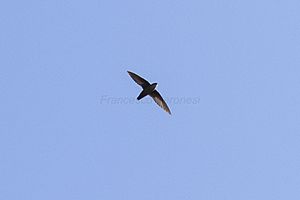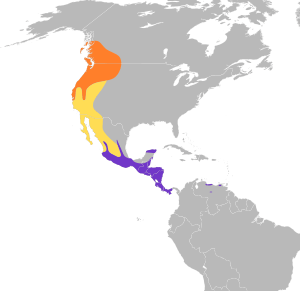Vaux's swift facts for kids
Quick facts for kids Vaux's swift |
|
|---|---|
 |
|
| In flight in Costa Rica | |
| Conservation status | |
| Scientific classification | |
| Genus: |
Chaetura
|
| Species: |
vauxi
|
 |
|
The Vaux's swift (Chaetura vauxi) is a small bird that lives in North America and northern South America. It is a type of swift, known for its fast and agile flight. This bird was named after an American scientist named William Sansom Vaux.
Contents
About the Vaux's Swift
This swift is quite small, even for a swift. It is about 10.7 to 11.2 centimeters (4.2 to 4.4 inches) long. It weighs around 18 grams (0.63 ounces), which is about the same as a few quarters. Birds living further north are a bit bigger, about 11.5 centimeters (4.5 inches) long. This might be because of something called Bergmann's rule, which suggests animals in colder places are often larger.
The Vaux's swift has a body shaped like a cigar. Its wings are curved like a crescent moon, and its tail is short and looks squared off. Its head, upper body, and wings are a dark, dusty black color. Its belly, rump, and tail feathers are a grayish-brown. The throat is a lighter gray, almost white in birds from the northern areas. Male and female swifts look very much alike. Young swifts have darker feathers at the base of their throats.
Where Vaux's Swifts Live
Vaux's swifts breed in high areas from southern Alaska down to central California. They also live from southern Mexico, including the northern Yucatán Peninsula, all the way to eastern Panama and northern Venezuela.
The swifts that live in the United States are migratory. This means they fly south for the winter. They spend their winters from central Mexico down through the areas where other swifts live all year round in Central America. Some birds that live in the southern part of their range all the time are sometimes called a different species, the dusky-backed swift.
These birds like to live in old forests. They prefer forests with both pine trees (coniferous) and trees that lose their leaves (deciduous). They need large, hollow trees to build their nests in.
Vaux's Swift Behavior
Vaux's swifts like to be with other birds. They often fly in groups of 30 or more. Sometimes, they even join other types of swifts, like the white-collared swift, especially when the weather changes. They fly with a mix of quick, stiff wing-beats and smooth, unsteady glides. They make many different sounds, including chattering, buzzing, squeaking, and chipping noises.
What Vaux's Swifts Eat
These swifts catch and eat insects while flying. Their diet includes beetles, wasps, termites, and flying ants. They look for food over forests and open areas, even in towns.
Vaux's Swift Reproduction
Vaux's swifts build their nests in mountains and foothills. In places like southeastern Alaska and Montana to central California, they usually nest above 700 meters (2,300 feet).
They make a cup-shaped nest using twigs and their own saliva. They stick the nest to a vertical surface inside a dark, hidden spot. This could be a hole in a tree, a crack in a cliff, or even an attic. Female swifts lay three white eggs between March and July. During the winter, these birds fly to warmer places in the tropics.
The Chapman Swifts
The "Chapman swifts" are a famous group of Vaux's swifts. They are part of a population that flies south for the winter. They gather every year in the chimney of Chapman Elementary School in Portland, Oregon. This is the largest group of Vaux's swifts found in North America.
Every evening from mid-August to mid-October, thousands of swifts gather in the sky above the school. This happens just before the sun sets. People have counted anywhere from 1,700 to 35,000 swifts at one time! Soon after sunset, over 10 to 30 minutes, they all fly into the top of the brick chimney. This chimney was built around 1925. They roost, or rest, inside the chimney until they leave at sunrise. The school is on the birds' migratory route. This route takes them to their winter homes in southern Central America and Venezuela.
Many people come to watch the swifts. The swifts also attract predators like peregrine falcons and Cooper's hawks, who try to catch them.
History of the Chapman Swifts
The swifts started using the school chimney in the early 1980s. They began using it because they had lost many of their natural roosting spots. These natural spots were old, hollow Douglas fir trees and dead standing trees called forest snags. Vaux's swifts naturally prefer to rest inside hollow trees.
To protect the swifts, the school stopped using its heating system during the weeks the birds were roosting. Students and teachers wore warm clothes, especially in late September when classrooms could get quite cool. Around 2003, the Audubon Society of Portland, along with school fundraisers and companies, raised money. They donated $60,000 to $75,000 for a new heating system for the school. This new system does not use the brick chimney. Now, the chimney is kept just for the birds to use.
See also
 In Spanish: Vencejo de Vaux para niños
In Spanish: Vencejo de Vaux para niños


